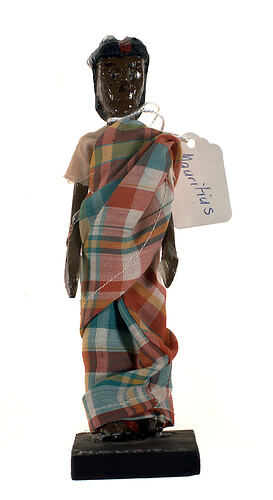Summary
National Doll produced to represent a Mauritian woman, it was given to Monica Gates by her mother in 1976. Mauritius was first settled by the Dutch in the 17th Century, then taken over by the French, who established a strong sugar cane plantation economy on the island bringing in Indian and African workers, Mauritius was then taken over by the British in the early 1800s and remained a British colony until it gained independence following World War II. Mauritian culture is a reflection of the mix of customs brought to the island by the different groups who have lived there, from the sari's worn by Indo-Mauritian women to the sega music and dance popularised by Mauritius' Creole population. In 2011 the Mauritian population is: Indo-Mauritian 68%, Creole 27%, Sino-Mauritian 3% and Franco-Mauritian 2%. The sari worn by this doll suggests she is dressed to represent an Indo-Mauritian woman.
The Gates collection contains 170 national dolls from 74 different countries and some correspondence relating to the acquisition of several of the dolls. The costumes of the dolls represent national costumes from the 19th Century to the 1990s. Monica Gates collected or was given these dolls between 1957 and 1990.
These dolls were purchased as souvenirs of particular countries and like many mass produced souvenirs they are often not accurate representations of a particular country or region, and may actually better reflect neighbouring counties or regions. This occurs because costumes are often stylised and simplified resulting dolls wearing generic costume elements which are common to many countries/regions. Often the fabrics and decorations used are selected to make the dolls cheap and easy to manufacture and aesthetically pleasing. This can result in the fabrics, colours and decorations of the doll's clothing having little or no reflection of the costume associated with a particular country or region they are meant to be representative of.
Physical Description
Doll, female, wooden. Mounted on a rectangular wooden base. Dressed in a red, green, yellow and white check sari-type garment with a cream coloured short sleeved shirt underneath.
More Information
-
Collecting Areas
-
Acquisition Information
Purchase
-
Place & Date Made
-
User
Mrs Monica Gates, Frankston, Greater Melbourne, Victoria, Australia, circa 1976-1990
-
Place Depicted
Mauritius
Doll is intended to represent an Indo-Mauritian woman. -
Inscriptions
"MAURITIUS [sic]" (-handwritten in white on wooden base" "Mauritius" (-written on attached paper tag)
-
Classification
-
Category
-
Discipline
-
Type of item
-
overall dimensions
4.5 cm (Length), 7.3 cm (Width), 16.5 cm (Height)
-
Keywords
Children's Play, Clothing, Cultural Awareness, Cultural Beliefs, Dolls, National Costumes, National Identity, Souvenirs

